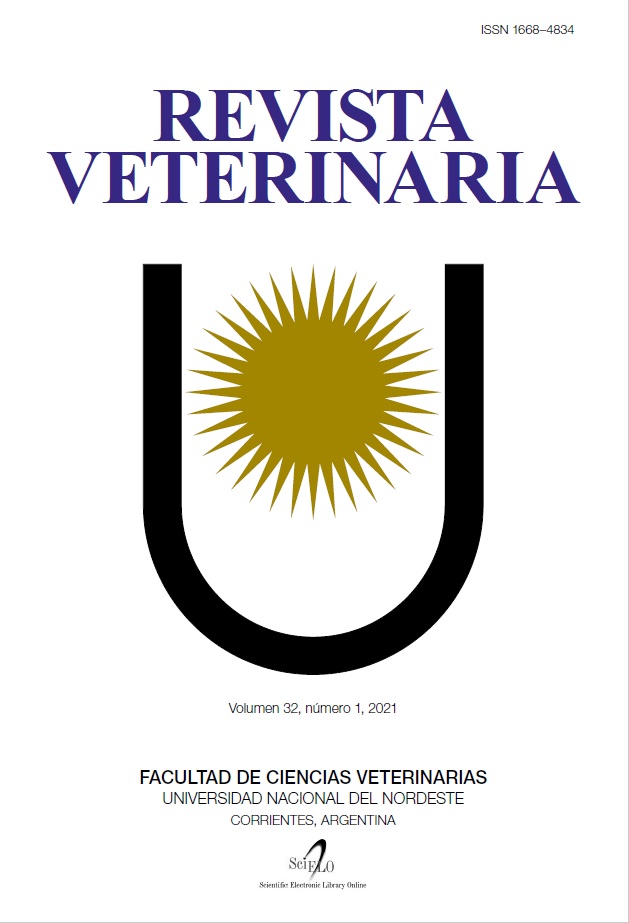Effect of resveratrol on the percentage and quality of in vitro embryos generated by separation of blastomeres in cattle
DOI:
https://doi.org/10.30972/vet.3215644Keywords:
clivage, embryonic development, total cells, living cellsAbstract
The oxidative state is an important factor that determines the development of bovine embryos. The objective in this study was to evaluate the effect of resveratrol on the quality of in vitro embryos generated by separation of blastomeres in cattle. Oocytes from the slaughterhouse were matured and fertilized in vitro by the conventional method. After 18 hours of fertilization, the zygotes were cultured for 3 days in synthetic oviductual fluid medium (SOF) for control and supplemented with 2 μM and 0.5 μM for the treatments. On day 3 they were stripped of their zona pellucida (ZP) to be cultivated at a rate of four blastomeres in well of the well (WOW) for 6 days in medium SOF supplemented with resveratrol. We evaluated percentage data of cleavage and embryonic division (8 to 10 blastomeres) after 3 days of culture, finding a significant difference p<0.05 with supplementation with 0.5 μM of resveratrol. At 6 days after blastomeres separation, percentage of embryos, number of total cells, live cells and dead cells were evaluated using Hoechst, FDA and PI staining respectively. There were no differences in the percentage of blastocysts between treatments; however, supplementation with 0.5 μM of resveratrol to the SOF medium had a greater amount of total cells and living cells (p<0.05). In conclusion, supplementation with resveratrol in the SOF medium does not increase the percentage of blastocysts but improves its quality using a concentration of 0.5 μM.Downloads
References
Galeati G, Spinaci M. 2015. Resveratrol from red grapes: an useful agent for oocyte maturation and subsequent embryonic development. Austin Journ Fertil 2: 1-3.
Gaviria S et al. 2018. Resveratrol supplementation promotes recovery of lower oxidative metabolism after vitrification and warming of in vitro produced bovine embryos. Reprod Fertil & Develop 31: 521-528.
Gambini J et al. 2013. Resveratrol: distribución, propiedades y perspectivas. Rev Españ Geriat & Gerontol 48: 79-88.
Giaretta E, Spinaci M, Bucci D, Tamanini C, Galeati G. 2013. Effects of resveratrol on vitrified porcine oocytes. Oxid. Med. Cell. Longev. ID 920257. DOI:10.1155/2013/920257.
Huang L, Shiao N, Hsuuw Y, Chan W. 2007. Protective effects of resveratrol on ethanol-induced apoptosis in embryonic stem cells and disruption of embryonic development in mouse blastocysts. Toxicology 242: 109-122.
Jhonson W, Loskutoff N, Plante Y, Betteridge K. 1995. Production of four identical calves by the separation of blastomeres from an in vitro derived four cell embryo. Vet Record 137: 15-16.
Johnson M, Nasr E.M. 1994. Radical solutions and cultural problems: could free oxygen radicals be responsible for the impaired development of preimplantation mammalian embryos in vitro. BioEssays 16: 31-38.
Kitagawa Y, Suzuki K, Yoneda A, Watanabe T. 2004. Effects of oxygen concentration and antioxidants on the in vitro development a lability, production of reactive oxygen species (ROS), and DNA fragmentation in porcine embryos. Theriogenology 62: 1186-1197.
Kwak S, Cheong S, Jeon Y, Lee E, Choi K. 2012. The effects of resveratrol on porcine oocyte in vitro maturation and subsequent embryonic development after parthenogenetic activation and in vitro fertilization. Theriogenology 78: 86-101.
Lee K, Wang C, Chaille JM, Machaty Z. 2010. Effect of resveratrol on the development of porcine embryos produced in vitro. J Reprod Dev 56: 330-335.
Liebfried L, First, N. 1979. Characterization of bovine folicular oocytes and their ability to mature in vitro. J Anim Sci 48: 76-86.
Liu Y et al. 2013. Resveratrol protects mouse oocytes from methyl glyoxal induced oxidative damage. PLoS One 8-10.
Nasresfahani M, Aitken J, Johnson M. 1990. Hydrogen peroxide levels in mouse oocytes and early cleavage stage embryos developed in vitro or in vivo. Development 109: 501-507.
Parrish J, Krogenaes A, Susko PJ. 1995. Effect of bovine sperm separation by swim up orpercoll on success of in vitro fertilization and embryo development. Theriogenology 44: 859-870.
Pirola L, Fröjdö S. 2008. Resveratrol: one molecule, many targets. IUBMB Life, 60: 323-332.
Salzano A et al. 2014. Effect of resveratrol supplementation during culture on the quality and cryotolerance of bovine in vitro produced embryos. Anim Reprod Science 151: 3-4.
Sato E, Matsuo M, Miyamoto H. 1990. Meiotic maturation of bovine oocytes in vitro: Improvement of meiotic competence by dibutyryl cyclic adenosine 3’5’monophosphate. J Anim Sci 68: 1182-1187.
SPSS Inc. 2007. SPSS for Windows, version 16.0. SPSS Inc., Chicago.
Takeo S et al. 2014. Resveratrol improves the mitocondrial function and fertilization outcome of bovine oocytes. Journal Reprod & Develop 60: 92-99.
Vajta G et al. 2000. New method for culture of zona-included or zona free embryos: the well-of-the well (WOW) system. Mol Reprod Dev 55: 256-264.
Zullo G. 2015. Natural antioxidants during in vitro culture improve embryo quality in cattle. Repositorio.untrm.edu.pe›bitstream›handle›UNTRM. Tesis Doctoral, p.1-162.
Downloads
Published
How to Cite
Issue
Section
License
Revista Veterinaria (Rev. Vet.) maintains a commitment to the policies of Open Access to scientific information, as it considers that both scientific publications as well as research investigations funded by public resources should circulate freely without restrictions. Revista Veterinaria (Rev. Vet.) ratifies the Open Access model in which scientific publications are made freely available at no cost online.











.jpg)
.jpg)



